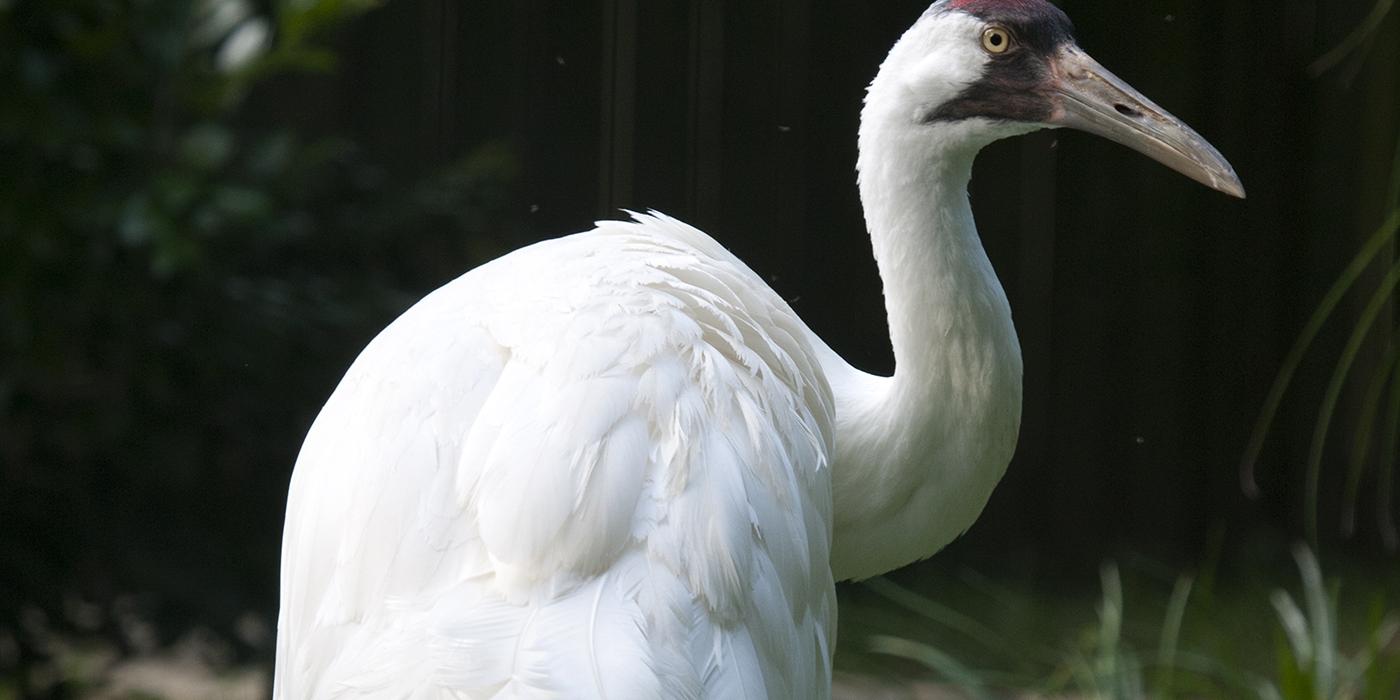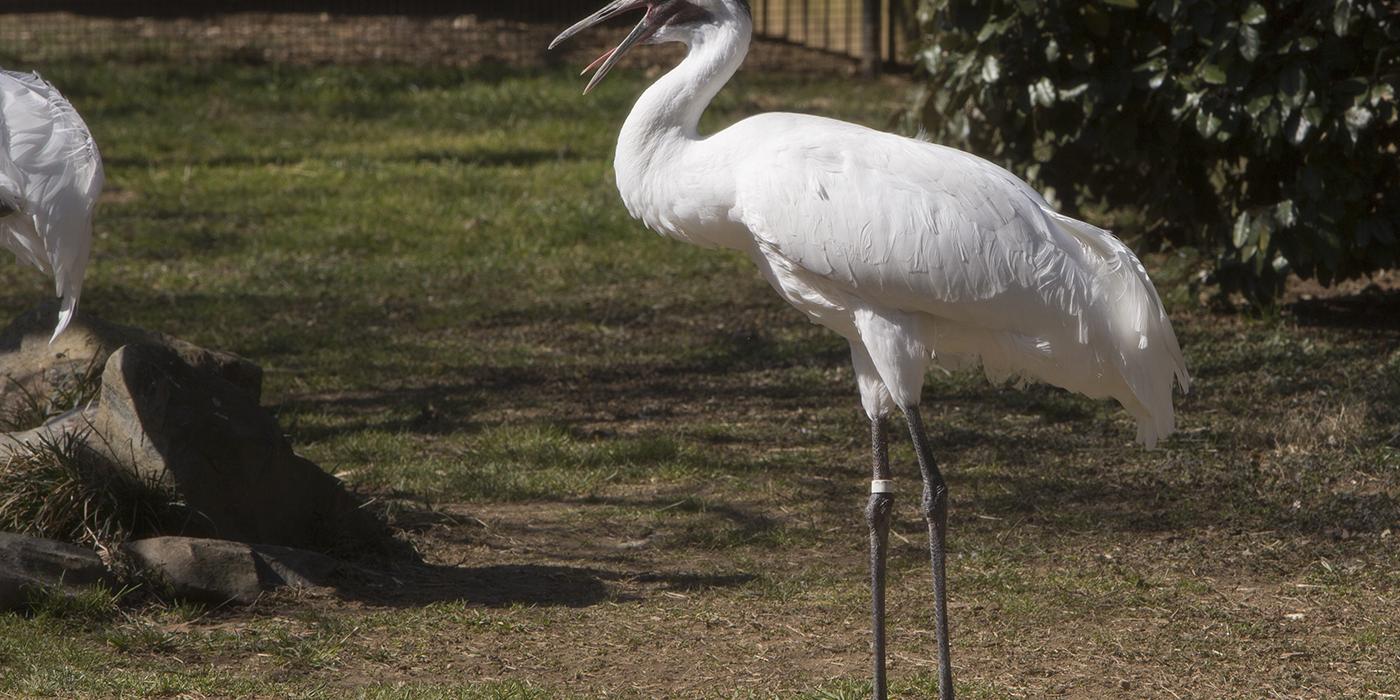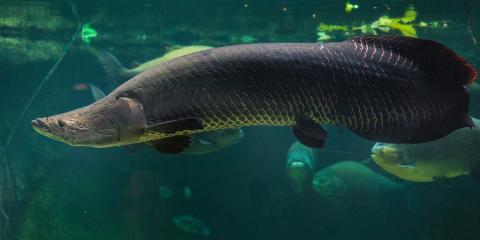Physical Description
The whooping crane is white with contrasting dark legs and a dark bill. Their primary wing feathers have black tips, their eyes are yellow and there is a pinkish hue at the base of the bill. Young are cinnamon in color along the back, with a dull gray or brown on the underbelly and blue eyes.
Size
Whooping cranes are the tallest birds in North America, standing an impressive 5 feet (1.5 m) tall with a 7-foot (2-meter) wingspan.
Native Habitat
Native to North America, almost all populations of whooping cranes are gone. One self-sustaining population of whooping cranes exists in the wild, which winters in the Aransas National Wildlife Refuge in Texas, then migrates to Wood Buffalo National Park in the Northwest Territories to breed.
A series of reintroduced, experimental nonessential populations on the East Coast and in the Rocky Mountain region have experienced varying degrees of success, but none have become self-sustaining.
Breeding occurs in prairie wetlands alongside shallow lakes, ponds and marshes that offer an abundance of vegetation. Cranes choose breeding habitats for their protection from predators, ability to visually detect surroundings and potential threats, and availability of food.
During migration, a 2,500-mile (4,000-kilometer) journey, whooping cranes will seek out wetlands and agricultural fields along the way. Brackish bays and coastal marshes are the preferred habitat for wintering.
Lifespan
The average lifespan for whooping cranes is 22 to 30 years in the wild, and 35 to 40 years in human care.
Communication
Vocal communication is essential for whooping cranes, and can be used to indicate danger, mating and flight, among other situations. Common predators for whooping cranes include black bears, wolves, foxes, coyotes and eagles.
Food/Eating Habits
Whooping cranes are omnivorous animals whose diet depends upon available food in their region. Blue crabs and wolfberries (also known as goji berries) are a staple of their diet, and can be supplemented with terrestrial and aquatic invertebrates, snakes, rodents and agricultural waste.
Sleep Habits
Whooping cranes are diurnal and will roost on the ground at night.
Social Structure
This species lives primarily in breeding pairs or small family groups, and will walk or fly to cover territory. Newly paired cranes often locate their first territory near that of their parents, and learn migration routes and behaviors from parents as well.
Reproduction and Development
Whooping cranes are monogamous birds that form pairs around 2-3 years of age. They will seek out a new mate if their initial mate dies. Pairs bond through a series of courtship rituals, including walking and calling in unison, and partaking in courtship dancing.
After forming a pair, whooping cranes begin nesting around age 4 and breed seasonally. Mating frequently occurs at daybreak.
Both males and females help built the nest, which normally consists of a flat mound of vegetation, surrounded by water. The female lays two eggs that hatch after an incubation period of 30 to 35 days. Eggs are primarily laid between April and May, and it is common for only one chick to survive.
Chicks fledge between 80 and 100 days, but young remain with their parents until 9 months of age. Maturity is reached at 4 years old.
Conservation Efforts
The Smithsonian's National Zoo and Conservation Biology Institute is leading the way in crane conservation. In 2018 a new breeding facility opened at the Smithsonian Conservation Biology Institute in Front Royal, Virginia with six breeding pairs. SCBI scientists regularly breed cranes using artificial insemination. The chicks that the pairs hatch will be candidates for reintroduction to the wild.
In addition to breeding cranes, SCBI studies their reproductive biology and endocrinology. Through their research, SCBI scientists have identified the components of a habitat that are necessary for whooping cranes in human care to successfully breed and raise chicks. They study whooping crane hormones through blood and fecal samples to determine how they affect the birds’ ability to lay fertile eggs. Those data combined with ultrasounds can help scientists understand the relationship between hormones and how follicles in the ovary develop. Scientists are also researching more effective methods to cryopreserve (freeze) whooping crane semen, which has proved challenging. If scientists can freeze semen, then it could be used to inject genetic diversity in the whooping crane population decades from now. That may be especially useful in the future since only 52 of the 163 whooping cranes living in human care are consistently laying eggs.
Whooping cranes have made a dramatic recovery in the past century, coming back from the brink of extinction. This species was reduced to fewer than two-dozen individuals in the early 1940s, and while current population numbers are up for debate, there is a consensus that whooping cranes are recovering, with breeding and reintroduction plans ongoing.
Historically, population declines were attributed to hunting and destruction of nesting habitats in favor of agricultural development. Current hazards include collisions with power lines, natural predation, inclement weather, climate change and oil spills.
U.S. Fish and Wildlife Service calls whooping cranes "a flagship species for the North American wildlife conservation movement." International recovery plans are underway to increase the size and genetic diversity of the wild flock. Experimental releases, breeding under-represented strains and even teaching captive-bred birds to migrate are all actions currently in place to help whooping cranes.
Help this Species
- Reduce, reuse and recycle — in that order! Cut back on single-use goods, and find creative ways to reuse products at the end of their life cycle. Choose recycling over trash when possible.
- Support organizations like the Smithsonian’s National Zoo and Conservation Biology Institute that research better ways to protect and care for this animal and other endangered species. Consider donating your time, money or goods.
- Share the story of this animal with others. Simply raising awareness about this species can contribute to its overall protection.
- Are you a student? Did you love what you learned about this animal? Make it the topic of your next school project, or start a conservation club at your school. You'll learn even more and share the importance of saving species with classmates and teachers, too.




